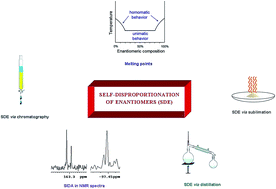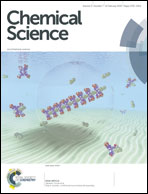The self-disproportionation of enantiomers (SDE): a menace or an opportunity?
Abstract
Herein we report on the well-documented, yet not widely known, phenomenon of the self-disproportionation of enantiomers (SDE): the spontaneous fractionation of scalemic material into enantioenriched and -depleted fractions when any physicochemical process is applied. The SDE has implications ranging from the origins of prebiotic homochirality to unconventional enantiopurification methods, though the risks of altering the enantiomeric excess (ee) unintentionally, regrettably, remain greatly unappreciated. While recrystallization is well known as an SDE process, occurrences of the SDE in other processes are much less recognized, e.g. sublimation and even distillation. But the most common process that many workers seem to be completely ignorant of is SDE via chromatography and reports have included all manner of structures, all types of interactions, and all forms of chromatography, including GC. The SDE can be either a blessing – as a means to obtain enantiopure samples from scalemates – or a curse, as unwitting alteration of the ee leads to errors in the reporting of results and/or misinterpretation of the system under study. Thus the ramifications of the SDE are relevant to any area involving chirality – natural products, asymmetric synthesis, etc. Moreover, there is grave concern regarding errors in the literature, in addition to the possible occurrence of valid results which may have been overlooked and thus remain unreported, as well as the potential for the SDE to alter the ee, particularly via chromatography, and the following concepts will be conveyed: (1) the SDE occurs under totally achiral conditions of (a) precipitation, (b) centrifugation, (c) evaporation, (d) distillation, (e) crystallization, (f) sublimation, and (g) achiral chromatography (e.g. column, flash, MPLC, HPLC, SEC, GC, etc.). (2) The SDE cannot be controlled simply by experimental accuracy and ignorance of the SDE unavoidably leads to mistakes in the recorded and reported stereochemical outcome of enantioselective transformations. (3) The magnitude of the SDE (the difference between the extremes of enantioenrichment and -depletion) can be controlled and used to: (a) minimize mistakes in the recorded experimental values and (b) to develop unconventional and preparatively superior methods for enantiopurification. (4) The magnitude of the SDE cannot be predicted but can be expected for compounds possessing SDE-phoric groups or which have a general tendency for strong hydrogen or halogen bonds or dipole–dipole or aromatic π–π interactions. (5) An SDE test and the rigorous reporting and description of applied physicochemical processes should become part of standard experimental practice to prevent the erroneous reporting of the stereochemical outcome of enantioselective catalytic reactions and the chirooptical properties of scalemates. New directions in the study of the SDE, including halogen bonding-based interactions and novel, unconventional enantiopurification methods such as pseudo-SDE (chiral selector-assisted SDE resolution of racemates), are also reported.

- This article is part of the themed collection: Most popular 2018-2019 supramolecular chemistry articles


 Please wait while we load your content...
Please wait while we load your content...